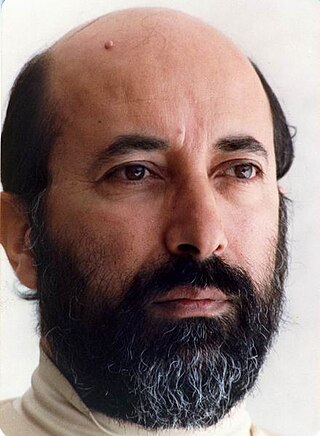Top Qs
Timeline
Chat
Perspective
Mostafa Chamran
Iranian physicist, politician and guerrilla fighter From Wikipedia, the free encyclopedia
Remove ads
Mostafa Chamran Save'ei (Persian: مصطفی چمران ساوهای) (2 October[citation needed] 1932 – 21 June 1981) was an Iranian physicist, politician, commander and guerrilla fighter who served as the first defense minister of post-revolutionary Iran and a member of parliament as well as the commander of paramilitary volunteers in Iran–Iraq War, known as "Irregular Warfare Headquarters". He was killed during the Iran–Iraq War.
Remove ads
Early life and education
Chamran was born into a religious family on 2 October[citation needed] 1932 in Tehran.[4][5] He received religious education from Ayatollah Taleqani and Morteza Motahari.[6] He studied at Alborz High School and then graduated from University of Tehran with a bachelor's degree in electromechanics.[4]
In the late 1950s, he moved to the United States for higher education, obtaining an M.S. degree from the Texas A&M University.[7] He then went on to obtain his PhD in electrical engineering and plasma physics in 1963 from the University of California, Berkeley.[8]
In the book Self-construction and development he said he was hired as a research staff scientist at Bell Laboratories and NASA's Jet Propulsion Laboratory in the 1960s.[9][10]
Remove ads
Career and activities
Summarize
Perspective
Chamran was one of the senior members of the Freedom Movement led by Mehdi Bazargan in the 1960s.[4][11] He was part of the radical external wing together with Ebrahim Yazdi, Sadegh Ghotbzadeh and Ali Shariati.[12]
Following graduation, Chamran went to Cuba to receive military training.[13] In December 1963, he along with Ghotbzadeh and Yazdi left the US for Egypt where he was trained in guerilla warfare.[14][15] They met the Egyptian authorities to establish an anti-Shah organization in the country, which was later called SAMA, special organization for unity and action.[12] Chamran was chosen as its military head.[12] Upon his return to the US in 1965 he founded a group, Red Shiism, in San Jose with the aim of training militants.[14] His brother, Mehdi, was also part of the group.[14] In 1968, he founded another group, the Muslim Students' Association of America (MSA), and it was led by Ebrahim Yazdi.[14] The group managed to establish branches in the United Kingdom and France.[14]
In 1971 Chamran left the US for Lebanon[14] and joined the camps of the Palestine Liberation Organization and the Amal movement.[13] He became a leading and founding member of the Islamic revolutionary movement in the Middle East, organizing and training guerrillas and revolutionary forces in Algeria, Egypt, Syria. During the civil war in Lebanon he actively cooperated with Musa Al Sadr, founder of the Amal movement.[16] Chamran also became an Amal member and "right-hand man of Sadr".[17][18]
Chamran along with Sadegh Ghotbzadeh was part of the faction, called the "Syrian mafia", in the court of Khomeini, and there was a feud between his group and the Libya-friendly group, led by Mohammad Montazeri.[19]

With the Islamic Revolution taking place in Iran, Chamran returned to Iran.[20] In 1979, he served as deputy prime minister in the cabinet of Mehdi Bazargan.[21][22] He led the military operations in Kurdistan where Kurds rebelled against the Interim Government of Iran.[21] He served as minister of defense from September 1979 to 1980,[23] being the first civil defense minister of the Islamic Republic.[24]
In March 1980, he was elected to the Majlis of Iran (the Iranian Parliament) as a representative of Tehran.[25] In May 1980, he was named the Ayatollah's representative to the Supreme Council of National Defense.[26]
Remove ads
Personal life
Chamran was married to a woman from Lebanon, Ghadeh Jaber.[27]
Death

Chamran led an infantry unit during the Iran–Iraq War and received two wounds in his left leg by shrapnel from a mortar shell.[9] However, he refused to leave his unit.[9] He was killed in Dehlavieh on 21 June 1981 as the war was raging on.[4][28][29][30][31] His death was regarded as "suspicious" and the related details have remained unclear.[20][32][33] Chamran was buried in the Behesht-e Zahra cemetery in Tehran.[9]
Remove ads
Legacy
Ayatullah Khomeini publicly proclaimed Chamran as a "proud commander of Islam".[9] Chamran was posthumously designated a hero and many buildings and streets in Iran and Lebanon were named for him, including major expressway.[9] In 2012, Mohsen Alavi Pour published Chamran's biography.[34] A species of moth was named after him in 2013.[35][36] Nick Robinson published an English biography of Chamran in the United Kingdom in 2013, 22: Not a new lifestyle for those who thirst for humanity!.[37]
In 2014 a film named Che (Persian: چ) directed by Ebrahim Hatamikia, was released to honour Chamran; the film portrays two days of Chamran's life after the Islamic Revolution.
In 2017 Iranian film director Reza Mirkarimi made an animated film about Chamran.[38][39]
Remove ads
See also
References
External links
Wikiwand - on
Seamless Wikipedia browsing. On steroids.
Remove ads

